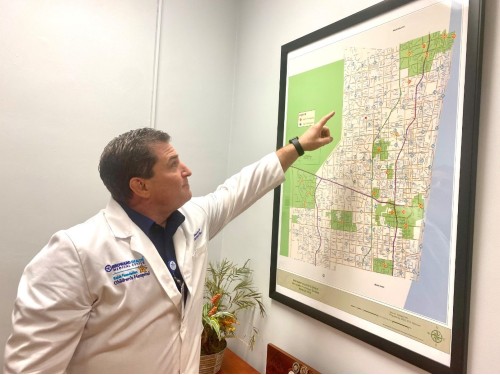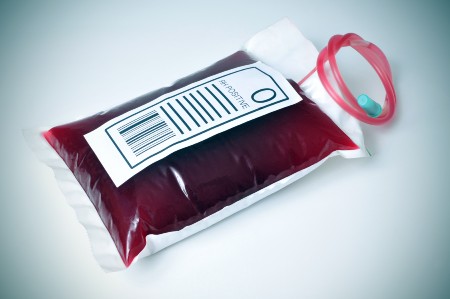Giving Trauma Patients a Fighting Chance
Dr. James Roach is on a mission to help more trauma patients have access to a potentially lifesaving and relatively simple treatment – a whole blood transfusion – before they arrive at the hospital.
 Dr. James Roach, system chief of emergency services at Broward Health and the District Chief of Emergency MedicineDr. Roach, who is the system chief of emergency services at Broward Health and the District Chief of Emergency Medicine, worked with the Broward County Sheriff’s Office (BSO) to establish the whole blood program in Broward County, making it the first in the state of Florida.
Dr. James Roach, system chief of emergency services at Broward Health and the District Chief of Emergency MedicineDr. Roach, who is the system chief of emergency services at Broward Health and the District Chief of Emergency Medicine, worked with the Broward County Sheriff’s Office (BSO) to establish the whole blood program in Broward County, making it the first in the state of Florida.
Emergency Medical Services (EMS) teams at the BSO have been trained and equipped to administer whole blood transfusions to trauma patients who are hemorrhaging before they are transported to the hospital.
This is a big change, as historically, EMS teams have mostly used isotonic IV fluids to treat hemorrhaging patients until they can get them to a hospital. These IV fluids have lots of negative effects, from diluting coagulation to making the patient’s body colder, explains Dr. Roach
“We are giving these patients a fighting chance that they have never had before,” said Health Clark, Division Chief of EMS at the BSO’s Department of Fire Rescue and Emergency Services.
On a recent evening around midnight, a battalion chief called Dr. Roach to ask for his help with a young woman in a serious car crash. Her legs were stuck under a collapsed dashboard, and she was going into hemorrhagic shock from internal injuries and bleeding. The crash occurred five minutes away from Broward Health North, but paramedics couldn’t get her out of the vehicle and were considering whether they needed to call a physician to perform an emergency amputation to save her life. Instead, paramedics gave her a whole blood transfusion while they worked to extricate her from the vehicle, and she survived and recovered fully, Dr. Roach said.
“You can’t argue against whole blood when you see EMS deliver a trauma patient who was in shock to the hospital with normal vital signs,” Dr. Roach said. “The outcomes are extraordinary.”
The most common cases of whole blood transfusion involve motor vehicle crashes. However, whole blood has also saved lives in other circumstances. One case involved a man who was hit by a boat propeller and almost died in the ocean. His torso was severely gashed, and his foot was severed at the ankle, said Dean Meadows, the EMS captain who responded to the call. He had experienced massive blood loss, but Captain Meadows gave him a whole blood transfusion on the scene that saved his life.
“He was so weak that he could barely speak, but soon after the blood began flowing into him, he whispered to me, ‘I don’t know what you are giving me, but don’t stop,” Captain Meadows said.
Nationally, trauma is the leading cause of death for people up to age 45, according to the American Association for the Surgery of Trauma, and among trauma patients, uncontrolled hemorrhage is the number one cause of preventable death.
Whole Blood in Broward County
Dr. Roach says whole blood is improving outcomes for trauma patients. About 75 of the 115 trauma patients in Broward County who have received whole blood transfusions from EMS have survived past the 24-hour mark.
“There is absolutely no shortage of stories where it saved a patient’s life,” Chief Clark said. “This stuff is like magic.”
Broward County launched the program in early 2020, but it faced delays due to the pandemic.
“It started with Dr. Roach and his dedication to this,” Chief Clark said. “He has been personally invested in combating this problem for trauma patients and helping solve something that we never had a real answer for in the past.”
In addition to his professional experience working in Emergency Departments over the past couple of decades and seeing the tragic outcomes of many trauma patients, Dr. Roach has strong personal motivation.
Dr. Roach’s niece, Taylor Brooke Lee, died in a tragic car accident in on April 4, 2018, at age 23.
“I have thought a lot about Taylor, and I have thought about how this is happening somewhere every day to someone’s loved one, and that we have to give our EMS more tools to try to save lives,” said Dr. Roach.
Dr. Roach and Chief Clark have been pleased to see that whole blood transfusions are doing just that.
Broward County also recently began giving tranexamic acid (TXA) to trauma patients in the pre-hospital setting. TXA stabilizes the fibrin clot to decrease bleeding from trauma, Dr. Roach explained.
What is Whole Blood?
Whole blood is natural blood from donors that is unseparated, meaning that it contains all the components of blood (red blood cells, white blood cells, platelets, and plasma).
The whole blood set up is relatively simple and inexpensive. Whole blood must be kept at four degrees Celsius, so it is kept in a small portable cooler. Paramedics use a small device called a QinFlow that warms the blood, and another device called a LifeFlow to manually pump the blood as it is transfused via Y tubing.
A growing body of evidence in peer-reviewed medical journals shows that whole blood can be a much better option than IV fluids for trauma patients in the pre-hospital setting and that it improves their chances of survival.
For example, a study published in the Journal of Trauma and Acute Care Surgery in 2020 compared outcomes of trauma patients who received a transfusion of whole blood with trauma patients who received only red blood cells and or plasma between November 2017 and June 2018. Controlling for patients’ ages, severity of injuries, and their pre-hospital physiology, receiving whole blood (compared to blood components) was associated with a two-fold increase in likelihood of surviving.
As whole blood evidence grows, hospital systems, such as Broward Health, have also started giving whole blood to trauma patients in the hospital setting. Dr. Roach explained that trauma patients in the hospital who need transfusions now get eight units of whole blood first before receiving blood components.
When trauma patients get a whole blood transfusion from EMS, they are given low-titer, O positive blood.
While O negative blood is considered the universal donor blood type (meaning this blood type can be transfused to anyone), O positive blood is the most common blood type. Both types of O blood lack anti-A and anti-B antigens seen in all other blood types, making both types of O blood possible candidates for use in emergency transfusions.
When describing blood types, positive or negative refers to Rh factor. Rh factor is a protein that may be found on the surface of red blood cells. People who have this protein are Rh positive, and those who do not are Rh negative.
Following the Military’s Lead
While whole blood transfusions given by EMS are relatively new, the U.S. Armed Forces have used whole blood transfusions for decades to save lives on the battlefield – dating back to World War I. Numerous studies have documented their successful outcomes, including one published in the Journal of the American Medical Association.
San Antonio, Texas is the pioneer in whole blood protocol for EMS. San Antonio launched its program in 2018 and has since provided whole blood transfusions to more than 1,000 patients. The program involves a multi-agency system led by the Southwest Texas Regional Advisory Council, and it includes the San Antonio Fire Department, and University Hospital (the local trauma center).
Seattle also launched a whole blood program in 2019. After determining it was a low-cost and efficient program, officials expanded it to the rest of the state. Other urban EMS departments, such as Houston, Minneapolis, New Orleans, and Pittsburgh have also adopted whole blood protocol in recent years.
Palm Beach County adopted a whole blood program in July 2022 after Broward County shared its model.
Answering the Call of Rising Trauma Cases
With trauma cases on the rise in Broward County, Dr. Roach hopes to expand the program to be able to be able to better serve the community. Broward Health has a Level I trauma center at Broward Health Medical Center and a Level II trauma center at Broward Health North.
Broward Health continues to see an increase in trauma patients in the system’s Emergency Departments. For example, overall blunt injuries (such as motor vehicle crashes, motorcycle crashes, pedestrian accidents, etc.) were up 13 percent in 2022 compared to 2021.
There are only two units for providing whole blood for Broward County, which spans a total area of 1,225 square miles (about the size of Rhode Island). Dr. Roach hopes to expand the reach by adding several more units to reach trauma patients more quickly and efficiently.
“We would have the opportunity to save so many lives if we could expand it,” Captain Meadows said. “I would put a unit with every battalion chief if I could.”
As Dr. Roach works to expand the reach of the whole blood program in Broward County, his niece’s legacy shines.
“Taylor has saved so many lives,” Captain Meadows said. “She is the reason Dr. Roach was so determined to get this program off the ground.”
Every time BSO paramedics save a life with whole blood, they say, “Here’s another one for Taylor.” Learn more about Emergency & Trauma Care at Broward Health.
|
Emergency Service & Trauma Care in Broward County | Broward Health Broward Health offers access to emergency services and trauma care in Florida. Learn more about emergency services that provide urgent pre-hospital treatment. |


